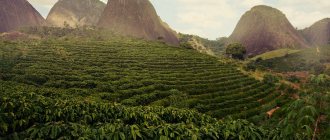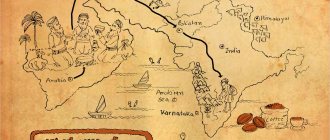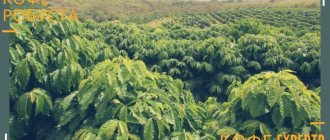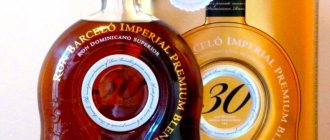| Souvenirs Rum Cigars Coffee Cocoa Cosmetics Fruits What is prohibited to export Tourist reviews |
The tropical Dominican Republic cannot leave you without positive emotions. Tourists are surrounded by the vibrant colors of the sea, sky and greenery of the jungle; taste buds enjoy rum cocktails and exotic fruit juices; The sound of the sea and the sounds of merengue caress your ears. How to share this tropical idyll with friends? Bring colorful souvenirs and gifts!
To make gifts from this country look like real Caribbean exoticism, and not reminiscent of Chinese factory production, we have compiled for you a list of the best options for what to bring from the Dominican Republic as a gift.
Photo: © Tatyana Lisker
What souvenirs to bring from the Dominican Republic
An original souvenir that you can bring from the Dominican Republic will be faceless dolls - Lima. In the Dominican Republic they produce unusual dolls - beautifully decorated and decorated, but with a clean face. Some tourists are frightened by such dolls, considering them to be a variation on voodoo dolls from the neighboring country of Haiti. But Dominican dolls are just a tribute to the local culture, which is a mix of peoples: aborigines, Spaniards, Africans. Lime dolls usually hold a basket or a bouquet of flowers in their hands. Basically, dolls are made of a special material - cold porcelain, but there are also less fragile specimens made of clay and corn flour. The simplest copies will cost from $3.
As small gifts from the Dominican Republic you can bring:
- Souvenirs made from shells and starfish . They will cost from 1 dollar.
- Coconut shell crafts . This could be: dishes, decorative crafts, magnets, amulets.
- Paintings by local painters . The minimum price for works by Dominican artists is $5. Basically, the paintings depict seascapes, portraits of colorful personalities, and settlements of local residents.
- Painted plates . Local plates differ from Chinese ones in their original patterns. There are not only round, but also square specimens. The average cost of a souvenir plate is $3.
- Shark amulets . Amulets are made from shark teeth. Perhaps this is the most original of the budget options to bring from the Dominican Republic as a gift. Prices for shark amulets start from a few dollars. It is believed that such an amulet has the strong energy of a shark and brings good luck to the owner.
- Handmade carpets . Dominican rugs are colorful and woven from coarse pile. They are not distinguished by sophistication, but fit well into ethnic-style interiors.
A unique souvenir from the Dominican Republic is larimar stone. The blue gem is often called the Dominican miracle. The uniqueness of this generally inexpensive stone is that it is mined only in the Dominican Republic. The world's only Larimar mine is located near the city of Barahona. Most often, the stone is framed in silver, the most beautiful specimens are framed in gold. The dark blue stone is considered the most valuable, since larimar loses its color over time. Silver jewelry costs from $10 at the markets.
Jewelry with larimar Photo: © Nikolay Ryskin
Coffee beans INDUBAN Gourmet 453 grams x 2 pcs
Coffee from the Dominican Republic - coffee that gives a delicious experience!
Santo Domingo is not only the capital of the Dominican Republic, but also a variety of excellent coffee, soft, with a light, delicate taste and a subtle floral aroma. All over the world, Santo Domingo (Santo Domingo) and Induban (Induban) coffee is valued precisely for its unique properties, and also for the fact that the drink turns out to be incredibly invigorating, refreshing, with a noble sourness. Coffee cultivation on the island of Haiti began in the 18th century. The climate in the country is more than favorable for growing coffee trees, so plantations are located everywhere: some are on the mountain slopes, where the sun “burns” the ripening beans every day, others are in the shade of nut and citrus trees, absorbing fresh ocean air. In each region of the republic, Santa Domingo coffee has its own taste, which can be explained by different growing and processing conditions. In the Dominican Republic, Santa Domingo and Induban coffee can be bought on every corner, and tourists coming here take advantage of this opportunity with great pleasure. They are attracted by the rich taste of coffee, the amazing aroma, and the thirst to taste real Dominican coffee, known far beyond the borders of their country.
This coffee can be compared with the more familiar Cuban coffee (Cubita, Serrano, Cuba, Turquino, Cubita), but more often it is compared with coffee grown in Jamaica - Jamaica Blue Mountain (Jamaica Blue Mountain) or simply JBM (Coffee Jamaica Blue Mountains) . Blue Mountain is one of the highest growing coffee varieties in the world. The largest and best portion of the coffee comes from the Walenford site, the smaller portion from Silver Hill and Estate Mountain. Wallenford is the most recognizable Blue Mountain coffee brand from Jamaica. This coffee has a perfectly balanced combination of aroma, body, astringency and sweetness, nutty flavor and moderate acidity. Jamaican coffee is one of the most expensive coffees in the world. Blue Mountain is practically unavailable on the international market: almost 90% of it is purchased by Japan, spending $15 million annually on this. The remainder of the harvest is almost entirely exported to the United States.
In Russia, prices for Blue Mountain can reach over $300. And of course, there is no guarantee that you will buy the Blue Mountain, especially since under the Jamaica Blue Mountains brand it is allowed to sell coffee containing 5% of the original beans!!!
In the Dominican Republic, the coffee harvest is more generous, and the geography and growing conditions, including altitude, are similar to Jamaica. By purchasing coffee in packaging from the country of origin, you are guaranteed to purchase 100% real Dominican coffee!
Santo Domingo is a Dominican coffee that is loved all over the world, but most of all it is valued by the Dominicans themselves. They can drink it day and night, adding huge amounts of sugar to the drink. This explosive combination of sweet and tart invigorates and perfectly tones. It is impossible to fall asleep after a cup of this strong drink, no matter how much you would like to! In this country, coffee is collected only by hand, dried only in the sun and prepared only using the traditional method - in the Turk. Coffee is often prepared in a geyser coffee maker. A geyser coffee maker allows you to get the most intense coffee possible. Due to completely natural processes of collection, drying, frying and cooking, the drink gets its rich taste, delicate aroma and a bright, long aftertaste with a floral tint. Many gourmets appreciate this and are ready to buy Santo Domingo coffee for its exceptional properties.
Interestingly, you can buy real Dominican coffee not only in local shops, but also in other countries or cities, for example in Moscow, Yekaterinburg, Nizhny Tagil, Kamesk-Uralsky, Chelyabinsk, Tyumen, Perm, Ufa, Surgut, Omsk, Novosibirsk, Nizhnevartovsk - after all, most of the coffee produced in the republic “leaves” beyond its borders to delight millions of people with its taste and aroma, who prefer to start their morning with a cup of a strong, invigorating drink.
———————-
From us you can order the maximum range of Coffee, cocoa and chocolate from the Dominican Republic. All products are certified.
Wholesale and retail sales in the Urals and Western Siberia region (Ekaterinburg, Chelyabinsk, Tyumen, Perm, Ufa, Surgut, Nizhnevartovsk, Kamensk-Uralsky, Nizhny Tagil, Zarechny, Nevyansk, Nefteyugansk, Noyabrsk, Khanty-Mansiysk, Varna, Magnitogorsk). Delivery is carried out by transport companies or by mail.
What rum to bring from the Dominican Republic
Rum is the most popular gift from the Dominican Republic. After all, local rum is considered one of the best in the world. There are several types of Dominican rum:
- Light - with a soft and sweetish taste. Most often used for making cocktails.
- Gold - with a noble amber-golden tint. It is consumed in its pure form, sometimes added to cocktails.
- Dark - has the richest taste, almost never consumed in its pure form. Dark rum is used in cooking and baking, in particular for impregnating rum baba.
- Flavored - with the addition of fruit juices. It tastes like tropical cocktails.
- Strong - in taste, in its pure form it resembles our vodka.
- Premium class - aged rum, consumed chilled in its pure form. Aged in oak barrels for 5 years or more.
It is not recommended to purchase rum from street vendors, even if you are offered a free tasting. Such a drink may have a pleasant taste, but you will not know the history of its production. Tourists, in reviews about which rum is best to bring from the Dominican Republic, write that it is also not worth shopping in branded stores - the prices there are too high. The best option is a regular supermarket.
How to determine the age of rum? You can find out how long the rum was aged in an oak barrel by the inscription on the label. "Anejo" - one year. "Extra Viejo" - from 3 to 5 years. "Reserva" - more than 5 years. In reviews, tourists write that the higher the aging of the rum, the lower the risk of a hangover in the morning. Rum aged up to 5 years costs about 10–15 dollars. Aged for more than 5 years - up to 40–50 dollars.
The most popular rum producers in the Dominican Republic are Brugal, Barselo and Bermudes. They are called 3 B. In order not to make a mistake with the quality, take rum no less than 10–15 dollars per 0.5 liter bottle. The best option for gift rum is Barcelo Imperial, which is aged for 12 years. In 2000, Barcelo Imperial rum was recognized as the best in the world. One bottle will cost about $35-$40. Also respected by locals and tourists: “Brugal 1888”, “Brugal Siglo de Oro”, “Bermudez 1852 Aniversario”. But the locals consider Punta Cana rum too touristy.
Dominican rum Photo: © Maksim Starostin
The rum-based alcoholic drink “Mama Juana” is offered. In addition to rum, it includes herbal preparations, honey, spices, red wine and wood from noble trees. The drink is credited with many medicinal properties. “Mama Juana” is considered by the Dominicans to be the elixir of life and a strong aphrodisiac. In addition to the ready-made drink, in the Dominican Republic you can purchase a dry set for preparing “Mama Juana”.
How much rum can you bring from the Dominican Republic? You can import no more than 2 liters of strong alcoholic drinks into Russia. Alcohol from Duty Free and goods in luggage are added up - of course, not all tourists are checked upon arrival, but alcohol can be legally confiscated if the limit is exceeded.
King of Dominican Coffee
The Santa Domingo variety is the best coffee in the Dominican Republic, and some experts call it the best highland variety in the world. It was named after the capital of the country, although it is grown in a different region.
Santa Domingo beans are sold under various coffee brands. This happens because the variety is grown on many plantations and enters the world market under different names.
Induban Gourmet
Another variation of the Santa Domingo variety. It has an unusual taste, in which creamy notes are clearly felt. It is soft, round, with a floral vanilla profile. It is extremely popular for its complex and multifaceted taste and pleasant balance of sweetness and acidity.
Cafe Pilon
The uniqueness of the variety is given by the growing conditions of coffee trees. They are surrounded by plantings of local vegetation with a high content of essential oils. Therefore, the grains of this variety have an unusual aroma of tea rose and herbs. In the aftertaste, tartness and citrus sourness are clearly visible. The taste is quite mild, even traditional coffee bitterness is almost not felt.
Cafe Tinto
It is no coincidence that coffee has the same name as a type of wine. In the taste of the finished drink, berry notes and a fruity-grape aroma are clearly distinguishable. The coffee is expressive, strong and thick.
Santa Domingo Aroma
The beans for this coffee are also called Santo Domingo, but are grown at a lower altitude. Therefore, the finished drink does not have such a dense and bright taste as its high-mountain counterparts. It has a nice sweetness, a chocolate base and a subtle dark fruit flavor to finish the cup.
Blasercafe Оcoa Santo Domingo
Under this name, expressive coffee is sold, with a sharp taste, chocolate and pepper notes, and almost devoid of sourness. The drink is very aromatic, dense, rich. Deeply roasted beans retain a high dose of caffeine, so a cup of this coffee is an excellent way to invigorate the morning.
We recommend this variety to those who have difficulty waking up in the morning.
What cigars to bring from the Dominican Republic
The most “masculine” gift that you can bring from the Dominican Republic is cigars. Most cigars in the Dominican Republic are made by hand. They consist of three parts: a cover sheet, a filler sheet and a bond sheet. Cigars can come in two shapes: parejos (straight, cylindrical) and figurados (indirect, shaped).
There are several sizes of cigars:
- Small : 100–106 mm in length.
- Medium : up to 124 mm.
- Large : up to 194 mm.
Its taste, aroma, and richness depend on the shape and size, as well as the diameter of the cigar. All this must be taken into account when choosing cigars from the Dominican Republic as a gift.
Cigars in gift wrapping Photo: © Tatyana Lisker
Travelers do not recommend purchasing cigars on the beach - most often they offer the cheapest tobacco, wrapped in banana or palm leaves. High-quality cigars (for example, “Arturo Fuente”) cost from $15 apiece, a souvenir box of small cigars costs $50. In addition to Arturo Fuente, the following brands are considered high quality: Davidoff, Courvoisier, Carbonell.
How many cigars can you bring from the Dominican Republic? The maximum allowed quantity of cigars for export is 50 pieces. Pure tobacco - 250 gr.
It is safer to buy in specialized stores - before purchasing, you can consult with the seller, smell the options offered, and even taste the most popular types. For a large batch of cigars, you should go to tobacco factories - they are located in Santo Domingo and La Romana.
By the way, even if you don't smoke, it's worth bringing a few cigars home. They can be used as air flavoring. When making cigars, tobacco leaves are sprinkled with various syrups and honey. In the home, the cigar gives a pleasant light aroma of dry tobacco and honey.
The price of pleasure
Almost all coffee produced in the Dominican Republic is produced under the Santo Domingo brand. At enterprises it is packaged mainly in vacuum foil bags weighing 453.6 grams. True, sometimes there are also smaller (227 and 100 grams) or large (1360 grams) packages. Local manufacturers rarely use traditional tin cans.
Coffee from the Dominican Republic is not often seen on the shelves of domestic stores for free sale.
This is understandable. After all, such a product is not cheap at all. Cost of Santo Domingo coffee
| No. | Product weight, grams | Price, rubles |
| 1 | 100 | 217 |
| 2 | 454 | 780-940 |
| 3 | 1360 | 2240 |
When you look at the numbers in the table, it becomes clear that Dominican coffee Santo Domingo cannot be called a budget product. It is purchased mainly by those who really love the classic strong drink with a pleasant, characteristic bitterness. Recently in Russia there are more and more such people wanting to do so. People are gradually learning to appreciate quality and understand drinks.
What coffee to bring from the Dominican Republic
Coffee, strong and sweet, is the favorite drink of the Dominicans. Everywhere you can find locals relaxing with a cup of coffee, or with a thermos filled with a hot drink for the whole day. Local Arabica, grown on plantations in the vicinity of the cities of Barahona, Cibao, Ocoa and Bani, has a mild taste without a characteristic bitterness.
Another advantage of local coffee is that 90% of all Dominican coffee is grown in environmentally friendly conditions, without the use of chemicals and pesticides. Dominican coffee is grown on small farms, which eliminates low-quality conveyor production. This coffee is called organic.
The most popular type of coffee in the Dominican Republic is Santo Domingo. Despite the name, coffee is not grown in the capital, but in the highlands. Santo Domingo coffee is sold under different brands. The beans are medium roast but have a dark roast coffee flavor. The taste of “Santo Domingo” has chocolate and nutty notes with a light, delicate sourness. This coffee is an inexpensive and practical option to bring home and friends from the Dominican Republic.
Have you brought coffee from the Dominican Republic and don’t know how to prepare it?
Traditional way of brewing Dominican coffee: Pour 2 tablespoons of finely ground coffee with sweetened water, add nutmeg (to taste) and let brew for 2-3 minutes. After this, the coffee must be passed through a fabric filter and milk added.
Among the varieties of Santo Domingo coffee you should try:
- "Induban Gourmet" - has a soft creamy taste. The complex floral-vanilla aftertaste of this coffee is appreciated all over the world.
- Cafe Pilon . This type of coffee grows in an area surrounded by vegetation with a high content of essential oils. Due to this, coffee has an extraordinary aroma of spices and tea rose. There is practically no traditional bitterness; the aftertaste is citrusy sour.
- Cafe Tinto . The wine name of coffee was not given by chance - the wine-fruit aroma is clearly felt. The taste has berry notes.
- "Santo Domingo Aroma" . The coffee is not grown in areas as high as the original Santo Domingo. Therefore, it has a less tart and rich taste. The taste has notes of chocolate and dark fruits.
- "Blasercafe Оcoa Santo Domingo" . The coffee lacks acidity. It has a spicy, peppery flavor with hints of chocolate. The drink is very invigorating due to its higher caffeine content.
Photo: © Tatyana Lisker
The second most popular coffee in the Dominican Republic, after Santo Domingo, is Barajona. The acidity of the drink made from Barajona beans is very low, the taste is based on chocolate and prune notes, there are also tones of caramel, tobacco and nuts. Coffee "Monte Alto" produces a special series for coffee machines called "Espresso".
Coffee prices in the Dominican Republic The exact price depends on the type of coffee. On average, 100 grams of roasted beans will cost 2–3 dollars. A 450g package of ground coffee will cost between $8-10. Green beans for roasting yourself can be purchased for $17–20.
Best coffee in the Dominican Republic
In the Dominican Republic, Santo Domingo is considered the best among varieties. According to experts, it surpasses even bean coffee grown in Brazil in its quality. It was named after the capital of the state, but it grows in a different region. This variety is sold under several names.
Induban Gourmet
Induban is one of the variations of Santo Domingo. Coffee from the Dominican Republic, produced under this brand, is characterized by unusual taste with a pleasant creamy tint and a floral-vanilla aroma . The variety is very popular. This is due to its multifaceted taste, a harmonious combination of sourness and unobtrusive sweetness.
Cafe Pilon
This type of coffee in the Dominican Republic is grown under special conditions. The plantations are surrounded by plants containing large amounts of essential oils. Therefore, coffee fruits acquire a unique aroma of spices and tea rose. Espresso prepared on their basis is characterized by a pleasant tartness with a citrusy, unobtrusive sourness. The taste is soft, with slightly noticeable bitterness.
Cafe-tinto
The products produced under this brand bear the same name as the wine variety. This is due to the presence of berry notes in the taste and a pleasant grape-fruit aroma. The drink turns out strong, dense and expressive.
Santo Domingo aroma
This coffee is called Santo Domingo, but it is grown at a significantly lower altitude. Due to this, Santo Domingo aroma is characterized by a less dense and rich taste than high-mountain varieties. It has a pleasant sweetness, an unusual chocolate flavor and a delicate fruity aroma.
Blasercafe Ocoa Santo Domingo
Coffee is ideal for making espresso in a coffee machine and brewing in a Turkish coffee pot. The drink turns out expressive, with quite bright taste. It contains chocolate and pepper notes and is almost completely absent of sourness. The beans are heavily roasted. They retain a fairly high concentration of caffeine. Therefore, choosing this variety is recommended for those who find it difficult to cheer up in the morning.
What cocoa to bring from the Dominican Republic
Cocoa balls are sold in the Dominican Republic. These balls are made from cocoa beans (dried, roasted and crushed) mixed with sugar, vanilla, cinnamon and other spices. Sometimes red pepper is added to the mixture. The cost of one ball of cocoa is about 1 dollar, jars (10 pieces) - from 5 dollars.
How to make Dominican cocoa balls? The balls are grated and filled with hot milk. The optimal ratio for one cup: 200 ml of milk and one ball of cocoa. In these proportions, you get delicious cocoa “like from childhood.” If you want a richer drink, more like hot chocolate than cocoa, use 2 cocoa balls. Instead of milk, you can use water - but then the mixture should be brought to a boil. You can make the drink thicker by replacing milk with cream.
Also in the Dominican Republic they sell the cocoa powder we are used to. A 250g package of local cocoa will cost $5. Chocolate bars with a high content of natural cocoa beans cost from 2-3 dollars.
Photo: © Victoria Zinina
Features of coffee from the Dominican Republic
The Dominican Republic has many mountain slopes, some rising 2200 - 2500 meters above sea level. This height allows you to grow elite coffee varieties. Dominicans are avid coffee drinkers. Everyone always drinks coffee here, regardless of age, health status, or time of day.
Traditional Dominican coffee recipes are easy to make. For example, boil 150 ml of water, add two teaspoons of finely ground coffee, add ground nutmeg and let it brew for two minutes, then pass through a fabric filter and serve with milk. The method of brewing coffee in sweetened water is also very popular. First, sugar is added to the water, and after boiling, coffee is added.
But even with the Dominicans’ great love for the drink, the country exports much more beans than it consumes.
Old Arabica beans are grown in the Dominican Republic. One of the best old varieties, Typica, predominates here. Coffee trees in most farms grow under the protection of taller brothers, which provide protection from the sun.
The peculiarity of Dominican coffee is the elongated and regular shape of the coffee beans. When peeled, they take on a blue-green hue.
As for the taste of coffee from the Dominican Republic, most varieties are high in strength and delight fans with chocolate notes. The sourness is very delicate, almost imperceptible.
What to bring from the Dominican Republic in terms of cosmetics
In tourist shops, most cosmetics are offered with low-quality ingredients - silicone, alcohol. Pay attention to the expiration date - for natural cosmetics it should be short. In reviews of what to bring from the Dominican Republic, tourists recommend purchasing cosmetics in shopping centers for locals.
What cosmetics should I bring from the Dominican Republic? The basis of Dominican cosmetics is vegetable oils, animal fats and various extracts. The most popular among our compatriots are:
- Cream based on snail mucus “Baba de Caracol” . The series of creams includes hair products that accelerate growth and promote rapid cell regeneration; face creams with a rejuvenating effect.
- Products with cocoa butter . The oil is used to moisturize dry skin and rejuvenate. There are products for hair, face and body, lip balms.
- Coconut oil . In its pure form, tourists use it to get an even tan. In creams - to moisturize the skin. A small 220 ml bottle of coconut oil costs between $3 and $5. Choose bottles labeled Virgin Coconut Oil.
- Cream with whale spermaceti . The cream with a rejuvenating effect is a favorite of local women, whose skin remains elastic and taut for a long time. According to reviews, the cream has a cumulative effect - with long-term use, wrinkles are significantly smoothed out. A 57 gram jar will cost from 30–40 dollars.
- Cream with noni fruit extract . The cream has a lifting effect and gives the skin a matte tint. Cost from 20 dollars.
Anti-cellulite scrubs with coffee beans, sea salt and cane sugar are popular. For small souvenirs you can buy coconut oil soap or black soap made from bananas.
Photo: © Igor_Yudakov
What fruits to bring from the Dominican Republic
The average annual temperature in the Dominican Republic is +24 degrees, so fresh fruits are available here all year round. They grow here:
- Oranges . They are used in the Dominican Republic only for juice. Dominicans add sugar and ice to freshly squeezed juice.
- Mango . The fruit was imported from India, but has taken root well. Now more than a hundred different varieties grow in the Dominican Republic.
- Avocado . The Dominican avocado is larger than what we are used to, its flesh is very tender and creamy.
- Passion fruit . The small, sour fruit is ideal for transportation: it has a hard peel and the pulp is reliably protected.
- Pineapples . They say that it was from the Dominican Republic that the first pineapples went to Europe. Pineapples in the Dominican Republic are sweet and juicy.
- Carambola . When cut, the fruit looks like a star and can be used to decorate desserts.
- Limonciyo . Sold in grape-like branches. The pulp is located under a thin skin and perfectly quenches thirst.
- Noni . The fruit with the smell of moldy cheese is incredibly healthy; its extracts are used in the fight against cancer.
- Anona . The fruit looks like a cone 10 cm long. Under the skin there is tender pulp that tastes like custard.
The average cost of 1 kg of fruit is $1. There are no restrictions on the export of fruit. How to bring fruit from the Dominican Republic? It is better to use plastic baskets for transportation. They are checked in as luggage along with the suitcase.
Photo: © Angela Popovich
What is prohibited to export from the Dominican Republic
You cannot take the national currency out of the Dominican Republic; you won’t be able to bring local pesos as a souvenir. Also prohibited for export are: products of animal origin (meat, milk); some types of orchids; self-obtained shells and starfish from natural reserves; palm tree core; turtle shells and corals; untreated precious and semi-precious stones.
What can tourists bring from the Dominican Republic? Alcohol (up to 3 liters is allowed to be exported from the country), fruits, coffee and cocoa - in unlimited quantities. If you plan to purchase a lot of alcohol, then it is better to take a dry set for Mama Juan. He is not subject to restrictions. It’s not difficult to prepare the drink according to the recipe - there are detailed recommendations on the Internet.
Photo: © Adelina30
Coffee Santo Domingo in Moscow and the Moscow region
Don't want to waste your family budget and waste money? And coffee still remains a favorite drink in the morning, when you get up and run to work, when solving problems is exhausting and you want to get moments of joy and pleasure. Or in the evening in front of the TV screen in a cozy chair and a soft fluffy blanket.
Our online store recommends elite coffee beans from the Dominican Republic, which is appreciated by millions of consumers in Moscow, the Moscow region and Russian cities. Coffee from the sunny Dominican country will become a favorite both for those who are trying this divine drink for the first time and for gourmets.
The grains are grown on environmentally friendly plantations without the use of chemical fertilizers. Dominicans are proud of the country's product and drink coffee everywhere: at home, at work, in banks and hospitals.
Dominican coffee is considered an elite raw material and is endowed with tonic qualities, deep taste and incredible aroma. Manufacturers of popular brands add premium beans from the Caribbean region to their famous blends, and residents themselves are proud of the beans they grow and drink coffee regardless of age.
The Santo Domingo variety is chosen by connoisseurs of strong coffee with chocolate notes without pronounced sourness. Santo Domingo coffee is not sold in traditional supermarkets. You can purchase first-class goods in the KOFERAI online store at an economical price, you just need to go to the website koferai.ru and order online or call 8-499-390-54-42,8-926-866-93-41.
Our managers will place an order for coffee from the Dominican Republic, and couriers will quickly and at the appropriate time deliver free of charge to the specified address when purchasing in the amount of 3,000 rubles. Don’t worry if you don’t live in Moscow or the Moscow region - we will deliver by transport companies or Russian Post.
We recommend buying 100% Arabica from sunny plantations, which is grown without the use of chemical fertilizers, in the COFERAY online store.
Reviews from tourists
What to bring from the Dominican Republic according to tourist reviews? Local rum, cigars and coffee. Tourists do not recommend buying these goods at Duty Free, since prices there are much higher and the choice is limited. It is also not recommended to purchase alcohol and cigars from beach vendors and souvenir shops at hotels.
What to bring from Punta Cana? In the Dominican Republic, the range of souvenir products does not differ much at different resorts. There are no special products in Punta Cana. This is the largest resort, so every possible option available is represented. In Punta Cana, tourists are advised to visit shopping centers: Palma Real Shopping Village and San Juan with a large grocery supermarket.
It is also not recommended to purchase goods at markets - only some designer crafts and paintings. Prices in markets are often 3–5 times higher. Even when bargaining, tourists usually overpay at least 2 times.
Video: what to bring from the Dominican Republic










